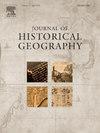威廉·琼斯爵士的印度植物学:视觉档案、自然历史收藏和大英帝国的世界创造
IF 1.1
2区 历史学
Q2 GEOGRAPHY
引用次数: 0
摘要
1784年,威廉·琼斯爵士抵达印度,在加尔各答的最高法院任职,在那里他对植物学产生了长期的兴趣。这导致了一篇关于印度植物的论文的计划,由于他在1794年英年早逝而未能实现。琼斯在植物学方面的努力,与他在文学、语言学和司法方面的努力相比,鲜为人知,研究这些努力有助于我们探索他的殖民世界。我的文章通过关注琼斯的视觉档案,特别是他从未在自己的作品中承认的印度艺术家的植物插图集,解决了这一学术差距。目前在伦敦的皇家亚洲学会,这些插图展示了视觉是如何成为自然历史调查的核心,并促进了大英帝国对印度植物世界的提取。这篇文章将琼斯定位为“计算的中心”,强调了科学与社会之间关系的复杂性,因为它与种族、权力和政治权威的问题纠缠在一起。琼斯的殖民世界创造与当地专业知识边缘化的“无世界”过程并行。这种双重运动,反过来,使殖民知识形成的不同前提变得更加清晰,对18世纪后期印度的生活和政治有影响。本文章由计算机程序翻译,如有差异,请以英文原文为准。
Sir William Jones's Indian botany: Visual archive, natural history collections, and worldmaking in the British empire
In 1784, Sir William Jones arrived in India to serve on the Supreme Court in Calcutta, where he developed his long-standing interest in botany. This resulted in a plan for a treatise on Indian plants which remained unfulfilled due to his untimely death in 1794. Examining Jones's botanical endeavours, much less known compared to his literary, linguistic, and judicial overtures, helps us explore his colonial worldmaking. My article addresses this gap in scholarship with a focus on Jones's visual archive, specifically a collection of botanical illustrations by Indian artists whom he never acknowledged in his work. Presently at the Royal Asiatic society in London, these illustrations demonstrate how visuality was central to natural historical investigation and facilitated the extraction of India's vegetal world for the British Empire. Situating Jones as a ‘centre of calculation’, this article highlights the complexities of the relationship between science and society, as entangled with questions of race, power, and political authority. Jones's colonial worldmaking was paralleled by a process of ‘worldlessness’ in the marginalisation of local expertise. This double-movement, in turn, brings into sharper relief the differential premises of colonial knowledge formation, with implications for life and politics in late eighteenth-century India.
求助全文
通过发布文献求助,成功后即可免费获取论文全文。
去求助
来源期刊

Journal of Historical Geography
Multiple-
CiteScore
1.50
自引率
10.00%
发文量
53
期刊介绍:
A well-established international quarterly, the Journal of Historical Geography publishes articles on all aspects of historical geography and cognate fields, including environmental history. As well as publishing original research papers of interest to a wide international and interdisciplinary readership, the journal encourages lively discussion of methodological and conceptual issues and debates over new challenges facing researchers in the field. Each issue includes a substantial book review section.
 求助内容:
求助内容: 应助结果提醒方式:
应助结果提醒方式:


